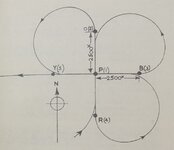islandee
Airman
I have a scenario over Uttaradit, Thailand where eight RAF Liberators were attacking a railroad marshalling yard, their primary target being locomotives. They seem to have been meeting little opposition and were described by locals on the ground as attacking, then circling, and attacking again (repeatedly?) (perhaps carelessly?). The aircraft during a sweep on a target were flying at about 300 feet (stated in reports). I ask these questions because we're trying to locate a crash site that is variously reported as being from three or four miles north of the target to 14 miles south of it:
1. Regardless of potential opposition, I presume that the attacking aircraft would have gone in at maximum speed, ie, about 300 mph, to minimize exposure to potential hostile fire?
2. What was the turning radius of a fully loaded and undamaged B-24 (they were armed for strafing and bombing)?
3. With locomotives as targets, presumably stationary in a yard, it would seem as if attacking them broadside would provide a bigger target than attacking down a track? (Photos of the flak gun taken by crews appear to me to have been taken during approaches perpendicular to the yard.)
What the Liberator crfews weren't aware of was a newly improvised sight and mounting used on a machine gun at the yard. See details of the attack at 06 Oct 1944.
I thank you.
1. Regardless of potential opposition, I presume that the attacking aircraft would have gone in at maximum speed, ie, about 300 mph, to minimize exposure to potential hostile fire?
2. What was the turning radius of a fully loaded and undamaged B-24 (they were armed for strafing and bombing)?
3. With locomotives as targets, presumably stationary in a yard, it would seem as if attacking them broadside would provide a bigger target than attacking down a track? (Photos of the flak gun taken by crews appear to me to have been taken during approaches perpendicular to the yard.)
What the Liberator crfews weren't aware of was a newly improvised sight and mounting used on a machine gun at the yard. See details of the attack at 06 Oct 1944.
I thank you.

